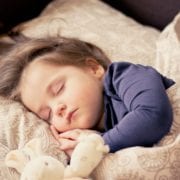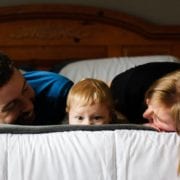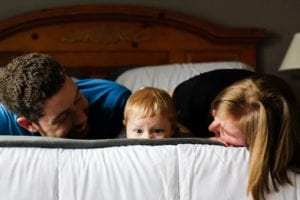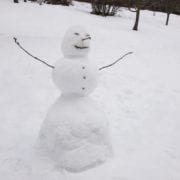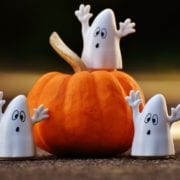Establishing good sleep habits for children with autism
By Dr. Breanne Hartley, BCBA-D
Senior Clinical Director
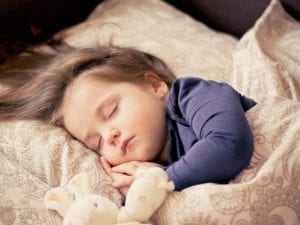 Approximately 25 percent of children have sleep problems. For children with autism, this percentage significantly increases to approximately 45-80 percent. It is extremely important for all children to get proper rest. A child who is not well rested will often demonstrate irritability, problem behavior, and potentially impaired academic performance.
Approximately 25 percent of children have sleep problems. For children with autism, this percentage significantly increases to approximately 45-80 percent. It is extremely important for all children to get proper rest. A child who is not well rested will often demonstrate irritability, problem behavior, and potentially impaired academic performance.
One of the most frequent sleep problems that children both with and without a diagnosis of autism have is onset latency, which is when a child has trouble falling asleep. It can often be even more difficult for your child to fall asleep in the summer when the days are longer and the nights are brighter. Some strategies to help decrease the time it takes for children with autism to fall asleep are:
Establish a bedtime routine
Start and maintain a regular bedtime, preceded by several calming activities that occur at the same time each night. For example, coloring from 7:30-7:45 p.m., bath from 7:45-8:15 p.m., read books from 8:15-8:30 p.m., bedtime at 8:30 p.m.
Limit physical activity
Physical activity is a must for healthy children. However, engaging in physical activity too close to a planned bedtime may interfere with falling asleep quickly. Consequently, encourage less rigorous activities closer to bedtime such as reading books, playing with blocks, arts and crafts, watching a movie, or playing board games.
Eliminate naps
One reason your child may not be falling asleep quickly is that he or she may not be tired. If your child is dependent on a nap during the day, begin gradually decreasing the length of that day-time nap. For example, if your child is accustomed to a two-hour nap, begin waking your child from that nap about 10-15 minutes earlier each week. This will allow for a transition away from napping in approximately two months.
Limit caffeine
It is no surprise that caffeine is a stimulant and should, therefore, be limited prior to sleep. Sodas are typically culprits of housing enough caffeine to keep your little ones awake, but also keep in mind that chocolate also contains caffeine. Therefore, limiting chocolate and foods that contains chocolate (like the summer favorite, chocolate ice cream) will be beneficial.
Reserve the bedroom for sleeping
Oftentimes, children’s bedrooms can serve a dual function as a playroom that houses many toys. Begin to reserve your child’s room solely for sleeping. Clearing out all toys and other distractions will help to establish the bedroom as a calm place that is kept for sleep.
Establish sleep expectations
It is common for children to get out of bed shortly after they are tucked in at night. Establish clear expectations so that your child understands he is not to get out of bed after bedtime. Resist the temptation to welcome your child into your bed to sleep for the night, as this may increase future instances of getting out of bed.
Faded bedtime
Another strategy is to keep your child awake until much later in the evening, past the time he typically falls asleep (for example, 11:30 p.m. versus 9 p.m.). This strategy helps a child fall asleep much more quickly because the child should be extremely tired. Then, gradually move bedtime up in small intervals of time (11:30 p.m., 11:15 p.m., 11 p.m., etc) until you reach a “reasonable” bedtime.
Staff Spotlight: Married couples at Little Star Center find work-family balance
Personal relationships in the workplace can be challenging, but the five couples at Little Star Center who mix work and marriage are finding a healthy balance. In celebration of Valentine’s Day, two of our couples share their stories of work-family balance.
Casey and Maggie Moore, married five years. Casey is program and clinical project specialist in Carmel and Maggie is clinical director of the early learner program in Carmel.
It’s safe to say Little Star Center sealed the deal for Casey and Maggie. He proposed after they both accepted job offers to work in Carmel six years ago. The couple, who met in a research methods class at Western Michigan University, has worked together in various jobs for nearly 17 years, much longer than they’ve been a couple. Their long history of jobs together, in addition to their roles in different programs at Little Star Center, makes their working relationship a little easier. Maggie cites a major perk of working together is that she can leave the driving to Casey each day.
When away from work, Casey and Maggie love quality time with their two children and enjoy the outdoors. They are training together for their first half marathon this summer.
Taylor and Kerri Butts, married five years.
Taylor is a Middle Star trainer in Carmel and Kerri is a scheduler for the Early Learner and In Home programs in Carmel.
Taylor and Kerri, high school sweethearts, have known each other for 13 years. This Valentine’s Day will be extra special because the couple is expecting their second child! Kerri says working in the same location as her husband while pregnant is an extra perk because, “if anything were to happen, I know exactly how to get a hold of him.”
Although the couple works in different programs at Little Star Center, they find time to check in on each other, especially on tough days.
Away from work, Taylor and Kerri keep talk about their jobs to a minimum and find joy in family time with their son, playing board games and training together for marathons.
Winter months mean getting creative with social and play skills
By Dr. Breanne Hartley, BCBA-D
Winter is upon us, as the leafless trees and cool temperatures will not let us forget. The cold winter months require different kinds of leisure activities for everyone, including children with autism. Children are no longer able to enjoy summer activities such as swimming in the local pool, or playing on the neighborhood swing set. Instead, children are oftentimes required to be indoors engaging in very different types of activities when the weather is cool.
Of course, we do not want the winter months to result in a decrease in social learning opportunities because oftentimes children with autism demonstrate deficits in social skills. These deficits may often consist of failing to make social initiations, failing to sustain conversations and preferring isolated play versus interactive play with other children. Many daily learning opportunities are required in order to help facilitate engagement in more appropriate social behavior. Therefore, although children are required to be inside for much of the next couple of months, it does not mean social and play opportunities with other children need to be put on hold. There are a variety of very fun social activities that you can encourage your child to participate in. For example, playing board games and creating arts and crafts.
Keep in mind that many people can act as “peers” to teach and facilitate social interactions; parents, siblings, grandparents, neighbors, cousins, and so many more!
Here are two ways you can make indoor activities a fun social opportunity for your child with autism:
Playing Board Games
Your child may have never shown interest in playing games like Chutes and Ladders or Hi-Ho-Cheerio, but that doesn’t mean you cannot teach them how. In order to make game-playing successful, start out with a small, easily achievable goal. For example, instead of playing the entire game on your first attempt, simply require that your child try one part of the game-playing experience. Initially, the “game” may be picking a color card from the deck in Chutes and Ladders, and saying “I got green”. Build in social opportunities by taking turns; your child picks a card and states the color, and then their brother picks a card and states the color. This allows your child to learn many new skills such as interacting with someone with a common goal, taking turns, and paying attention to someone else as they take their turn.
Arts & Crafts
Engaging in arts and crafts activities is another great way to encourage social interactions. With winter approaching, it would be seasonally appropriate to make a snowman craft. You can be creative and make a snowman however you’d like out of construction paper, pipe cleaners, cotton balls, “bug” eyes, etc. Once your snowman is complete, provide your child with similar materials that you used, and tell her to “Make a snowman like mine!” Your child will have fun attempting to match her snowman with yours by referencing what your model looks like. As your child puts each piece of the snowman together, start up conversation such as, “My snowman’s scarf is red. What color is your snowman’s scarf?”, “Look, my snowman has a hat to keep his head warm. What keeps his hands warm?”, “My snowman’s mittens are red like an apple. Your snowman’s mittens are green like (have your child fill in the blank).” Once both snowmen are complete, use them to play interactively by pretending they are riding in cars, sliding down slides, and building blocks. This arts and crafts activity allows your child to learn new skills such as copying a craft modeled by someone else, and engaging in conversation.
Enjoy playing with your child, and stay warm this winter!
Breanne is senior clinical director at Little Star Center.
Little Star Center clinical director selected to serve on BACB committee
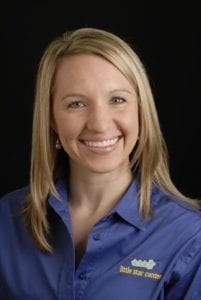 Congratulations to Dr. Breanne Hartley, senior clinical director at Little Star Center, who will serve as a coach on the Behavior Analyst Certification Board’s (BACB) Code Compliance Committee (CCC). Dr. Hartley was selected to serve on the committee, which helps certificants who could benefit from consultation, experience, and/or educational information to address less egregious alleged ethical violations.
Congratulations to Dr. Breanne Hartley, senior clinical director at Little Star Center, who will serve as a coach on the Behavior Analyst Certification Board’s (BACB) Code Compliance Committee (CCC). Dr. Hartley was selected to serve on the committee, which helps certificants who could benefit from consultation, experience, and/or educational information to address less egregious alleged ethical violations.Staff Spotlight: Jeremy Cole, Lafayette West, Program Manager Apprentice
As a program manager apprentice, Jeremy is responsible for assisting the program managers at Little Star Center Lafayette West with daily clinical activities, including generalization testing and graphing. Jeremy also is responsible for coordinating our staff volleyball leagues.
Here’s more information about Jeremy:
What do you most enjoy about your job at Little Star Center? Getting an opportunity to be a part of the growth of the children every day and to be able to see the evidence of ABA therapy and its effectiveness.
What’s the best advice you’ve ever been given? If they can’t learn the way we teach, we teach the way they learn.
One thing I want people to know and understand about working with children affected by autism is….working with one child who has autism is working with one child who has autism. No two individuals with autism are the same.
What are your favorite activities when not working at Little Star Center? I love following my sports teams from Michigan and going to concerts. I also love traveling to see my family in Michigan and Tennessee.
Little Star Center creates wish list for #GivingTuesday
Please consider helping Little Star Center gather much-needed supplies on our wish list on #GivingTuesday, an annual campaign to encourage communities to give back to charities and causes they support. Parents, businesses and others in the community can help us meet the needs of our wish list on or before #GivingTuesday on Nov. 29. Items will be accepted at all Little Star Center locations.
Financial contributions also can be made for these items and to support Little Star Center’s scholarship program, which serves as a safety net for families facing insurance challenges, also are accepted. Click here to donate. Please designate your donation as #GivingTuesday. Please email Milissa Harman at milissahbr @littlestarcenter.org for more information or if you have questions.
Little Star Center’s Wish List for #GivingTuesday
All centers
Wii consoles
Wii games (family rated)
iPads (used, good condition)
Bloomington
| Legos
Trains Train tracks Erector set Basketball hoop (kid size) Basketball hoop for outdoors Tee ball Soccer ball and net
|
Playdoh
Adult tricycle Kids bike with training wheels Group YMCA membership Magic Sand Counting Bears Felt board and playset
|
Carmel
Secure, adaptive swing with straps or a support bar and full back for learners up to age 12
Early Learner Program
K’Nex
Mario K’Nex
Baby dolls and supplies (bottles, bath tub, stroller, etc.)
Unbreakable mirrors for learner play
Lafayette West
Christmas tree
Holiday decorations
Wagon
VHS player
Bike with training wheels (medium sized)
Trick-or-Treating: Yes, They Can!
By Dr. Breanne Hartley, BCBA-D
With Halloween coming next week, many parents who are affected by autism may be hesitant to have their children participate in the traditional trick-or-treating festivities.
Many parents I work with at Little Star Center have shared that they want nothing more than for their children to “just be a kid” and participate in all of the fun activities. However, their hesitancy often stems from uneasiness that their child may be too overwhelmed by the whole process of getting dressed into a foreign costume, and having several social interactions with each ring of a new doorbell.
However, don’t ever think “my child can’t do this.” Your child can do this!
Even if it doesn’t appear that your child shows any interest in Halloween festivities, (possibly like your other children, who have been extremely excited to wear their costume for the past several weeks) you can teach your child with autism how fun Halloween really can be. You can do this using an Applied Behavior Analytic teaching method, called pairing (which is the behavioral word for “associating”). The one part of the trick-or-treating festivities that truly makes it Halloween, is wearing a costume. In order to get your child prepared for strolling the neighborhood in costume, start providing some learning opportunities ahead of time. Several days before Halloween, begin dressing your child in their costume, while simultaneously allowing him to play with his favorite toy or eat his favorite snack. At first, just short periods of time of wearing the costume will be sufficient just to get your child accustomed to wearing something different. During that first time, glance at the clock and determine approximately how long your child tolerated having their costume on before they began to tug at it and want it off. This time period will tell you how long to keep it on the next time.
If the first occurrence was a time period of two minutes, then make a mental note to take the costume off at about one minute and 30 seconds the next time. You don’t want you’re your kiddo to exceed his or her limit. Then, over time, with continued practice, gradually increase the amount of time that you keep the costume on. Just remember to “pair” fun things (toys, snacks, movies) with wearing the costume, each and every time. Eventually, your child may begin to learn that Halloween and dressing up in a costume can be quite enjoyable.
Happy trick-or-treating!
Dr. Breanne Hartley is a clinical director at Little Star Center.
Staff Spotlight: Amanda Jones, Program Manager, Little Star Center Bloomington
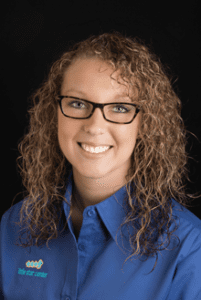 Amanda has worked at Little Star Center Bloomington for two years. As program manager, she creates and supervises individualized plans for learners on her caseload. Amanda also provides supervision to RBTs and students who will sit for the BCBA exam. Soon, Amanda will have a new title: Mom! She and her husband, Braeden, are expecting their first child, a daughter, this month. Here’s more about Amanda:
Amanda has worked at Little Star Center Bloomington for two years. As program manager, she creates and supervises individualized plans for learners on her caseload. Amanda also provides supervision to RBTs and students who will sit for the BCBA exam. Soon, Amanda will have a new title: Mom! She and her husband, Braeden, are expecting their first child, a daughter, this month. Here’s more about Amanda:
What do you most enjoy about your job at Little Star Center Bloomington? I really enjoy developing individualized programming for learners and working as a team in Bloomington. Nothing is more rewarding than seeing learners progress from their first day and hearing the successes that parents see at home.
What’s the best advice you’ve ever been given? Never give up and keep trying.
One thing I want people to know and understand about working with children affected by autism is…. Every single learner is different and they have their own interests and strengths. The best part about this job is that every day is a little bit different. Different teaching methods are successful with different learners and what is motivating to a learner one day may not be motivating the next.
What are your favorite activities when not working at Little Star Center? I love to go to auctions, shop at antique stores, and play with my dogs. We have one Australian shepherd, one shih tzu, five walker coon dogs, and one beagle.
Staff Spotlight: Tabitha Hays, In-Home Program Manager
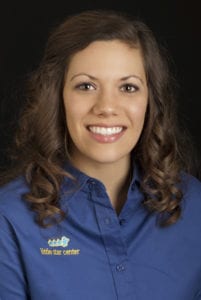 Tabitha Hays has been with Little Star Center for two years, serving as an in-home program manager. Tabitha focuses on autism services in Indianapolis.
Tabitha Hays has been with Little Star Center for two years, serving as an in-home program manager. Tabitha focuses on autism services in Indianapolis.
What do you most enjoy about your job at Little Star Center? Helping kids and families affected by autism so that they can enjoy life and function better at home and in the community.
What’s the best advice you’ve ever been given? We do not need to think alike to love alike.
One thing I want people to know and understand about working with children affected by autism is…. If you treat people like they have a disability, they will. Instead, treat them as you would treat any other person.
What are your favorite activities when not working at Little Star Center? Gardening, cooking, fermenting foods and beverages, hiking, bike riding, reading.

